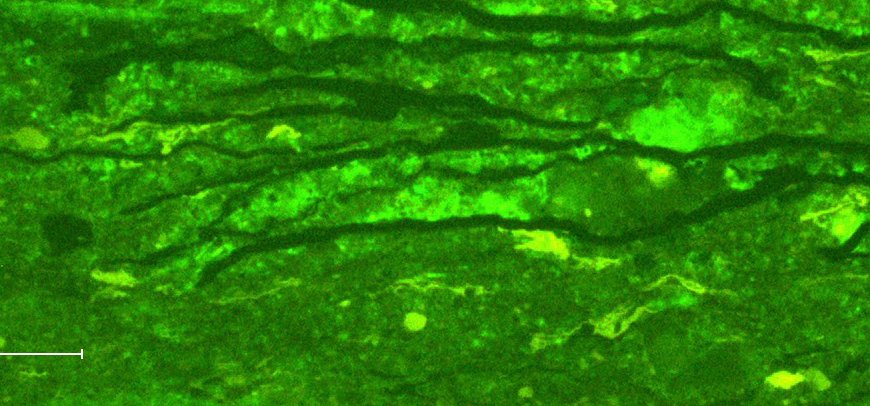Rocks with a high crude oil potential are often rich in uranium. Oil exploration companies make use of this: they measure the radiation via test drillings. Scientists from the GFZ section Organic Geochemistry together with Danish and Russian colleagues now discovered that the radiation has a destructive effect on the oil formation potential of a rock. The team was able to develop a method to quantify this destruction process. The results, published in Geochimica et Cosmochimica Acta, may prevent oil drilling companies from unprofitable exploration efforts.
Crude oil forms when material rich in organic matter, especially material of algal origin, is deposited and decomposed on geologic time scales. For a crude oil deposit being profitable to drill for, the amount of organic matter of the parent rock material needs to be sufficiently high – this is true for example for so called mudstone, which often serves as parent rock material. Mudstone often contains high amounts of uranium, a fact used by oil companies for their drill hole measurement processes. In general, the amount of uranium in dark mudstone (‘black shale’) is as high as 20 ppm, 20 parts per million. Particular depositional conditions may, however, lead to several hundred ppm.
In their current study the scientists investigated the so called Alum Shale via several drill holes along the northern Baltic Coast. With uranium contents up to nearly 500 ppm this mudstone is a major source for oil and gas in that region. The drill cores span about 500 million years, thus reaching back to the Cambrian age – the time of the ‘Cambrian explosion’ when nearly all of today’s animal phyla originated. Based on these drill cores the scientists were for the first time able to comprehensively investigate the complex interplay between uranium radiation and organic material within the rock over long geologic timespans.
They were able to show that the Alum Shale produces less oil but more gas. Hans-Martin Schulz, co-author of the study: “The biofilm that was deposited during that time in the shallow water environment of today’s Baltic Sea must have been formed by planktonic material and therewith have been rich in long-chained hydrocarbons that turned into petroleum over time. During millions of years of radiation, however, the long chains were cut. Today, there is some gas left that is made of short-chained hydrocarbons”. Yet, the uranium radiation is still high.
If now a petroleum company measures the enhanced radiation, the potential of the subsurface to bear petroleum seems to be high. This was indeed true for the past but today, not much crude oil is left in the rock. Drilling for oil is not profitable. The scientists conclude that before drilling for oil, the original depositional conditions need to be reconstructed.
First author Shengyu Yang, GFZ: “Only if we know how the organic matter looked like 400 million years ago we are able to estimate the crude oil and gas potential of a deposit.” The methods to quantify the degradation process of the organic matter presented in the study may prevent over-optimism on natural gas reserves in Northern Europe. The findings allow for a pinpoint search for petroleum occurrences and reduce the risk of unpromising, expensive exploration efforts. (ak, jz)
Original study: Yang, S., Schulz, H.-M. , Horsfield, B., Schovsbo, N.H., Noah, M., Panova, E., Rothe, H., Hahne, K., 2018. On the changing petroleum generation properties of alum shale over geological time caused by uranium irradiation. Geochimica et Cosmochimica Acta 229, pp 20-35. DOI: 10.1016/j.gca.2018.02.049








![[Translate to English:] Torsten Sachs in front of a climate station on a field](/fileadmin/_processed_/3/9/csm__TorstenSachs_bearbeitet_GS_4a1365ef84.jpeg)

![[Translate to English:] left image flood at the Ahrtal: image from above, several houses are flooded; left image:: Heidi Kreibich;](/fileadmin/_processed_/4/4/csm_Bild2_9af0130e9f.png)



![[Translate to English:] Start der Vega Rakete](/fileadmin/_processed_/6/4/csm_20231201-kachel_Vega-VV23-launch_ESA-CNES-Arianespace_706716b68c.jpeg)









![[Translate to English:] Poster exhibition at the Brandenburg Hydrogen Day at the GFZ, some participants in the foreground](/fileadmin/_processed_/6/5/csm_Erster_Brandenburgischer_Wasserstofftag_GFZ_402fcec95e.jpeg)
![[Translate to English:] Group picture of the participants](/fileadmin/_processed_/9/4/csm_20231108_CAWa-Workshop-Tashkent_Gruppenbild_99ea779d8a.jpeg)

![[Translate to English:] [Translate to English:] Hörsaal](/fileadmin/_processed_/e/6/csm_H%C3%B6rsal_e21ac645fb.jpeg)


![[Translate to English:] The Delegations in the Historic Library on the Telegrafenberg. In the back there are from left to right, the Dutch Ambassador for Germany, Ronald van Roeden, the Dutch Minister for Education, Culture and Science, Robbert Dijkgraaf and the scientific director of the GFZ, Susanne Buiter.](/fileadmin/_processed_/d/b/csm_Kachel-2_9eba4b4212.jpeg)

